formerly eScholarship Editions


|
|
|
|
Your request for similar items found 20 book(s). | Modify Search | Displaying 1 - 20 of 20 book(s) | |
| 1. | 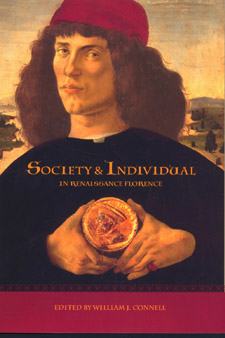 | Title: Society and individual in Renaissance Florence Author: Connell, William J Published: University of California Press, 2002 Subjects: History | Renaissance History | European History Publisher's Description: Renaissance Florence has often been described as the birthplace of modern individualism, as reflected in the individual genius of its great artists, scholars, and statesmen. The historical research of recent decades has instead shown that Florentines during the Renaissance remained enmeshed in relationships of family, neighborhood, guild, patronage, and religion that, from a twenty-first-century perspective, greatly limited the scope of individual thought and action. The sixteen essays in this volume expand the groundbreaking work of Gene Brucker, the historian in recent decades who has been most responsible for the discovery and exploration of these pre-modern qualities of the Florentine Renaissance. Exploring new approaches to the social world of Florentines during this fascinating era, the essays are arranged in three groups. The first deals with the exceptionally resilient and homogenous Florentine merchant elite, the true protagonist of much of Florentine history. The second considers Florentine religion and Florence's turbulent relations with the Church. The last group of essays looks at criminals, expatriates, and other outsiders to Florentine society. [brief] Similar Items |
| 2. | 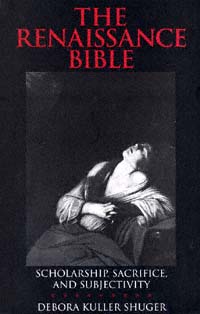 | Title: The Renaissance Bible: scholarship, sacrifice, and subjectivity Author: Shuger, Debora K 1953- Published: University of California Press, 1994 Subjects: Literature | Religion | Literary Theory and Criticism | Renaissance History | Christianity | Renaissance Literature Publisher's Description: This is the first book on the Renaissance Bible by an Anglo-American scholar in nearly fifty years. Not confined to a history of exegesis, it is instead a study of Renaissance culture - a culture whose central text was the Bible. Shuger explores, among other topics, the links between late medieval Christology and early modern subjectivity; religious eroticism and the origins of the sexualized body; the transformation of humanist philology into comparative religion; and the representation of daughter-sacrifice and female erotic desire. [brief] Similar Items |
| 3. | 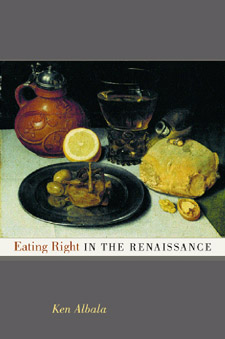 | Title: Eating right in the Renaissance Author: Albala, Ken 1964- Published: University of California Press, 2002 Subjects: Food and Cooking | Renaissance History | History of Science | History of Food Publisher's Description: Eating right has been an obsession for longer than we think. Renaissance Europe had its own flourishing tradition of dietary advice. Then, as now, an industry of experts churned out diet books for an eager and concerned public. Providing a cornucopia of information on food and an intriguing account of the differences between the nutritional logic of the past and our own time, this inviting book examines the wide-ranging dietary literature of the Renaissance. Ken Albala ultimately reveals the working of the Renaissance mind from a unique perspective: we come to understand a people through their ideas on food. Eating Right in the Renaissance takes us through an array of historical sources in a narrative that is witty and spiced with fascinating details. Why did early Renaissance writers recommend the herbs parsley, arugula, anise, and mint to fortify sexual prowess? Why was there such a strong outcry against melons and cucumbers, even though people continued to eat them in large quantities? Why was wine considered a necessary nutrient? As he explores these and other questions, Albala explains the history behind Renaissance dietary theories; the connections among food, exercise, and sex; the changing relationship between medicine and cuisine; and much more. Whereas modern nutritionists may promise a slimmer waistline, more stamina, or freedom from disease, Renaissance food writers had entirely different ideas about the value of eating right. As he uncovers these ideas from the past, Ken Albala puts our own dietary obsessions in an entirely new light in this elegantly written and often surprising new chapter on the history of food. [brief] Similar Items |
| 4. | 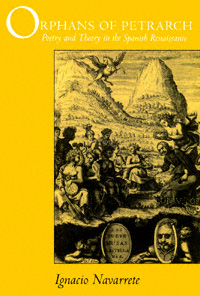 | Title: Orphans of Petrarch: poetry and theory in the Spanish Renaissance Author: Navarrete, Ignacio Enrique 1954- Published: University of California Press, 1994 Subjects: Literature | Literary Theory and Criticism | Poetry | Renaissance Literature Publisher's Description: In Spain as elsewhere, Renaissance poets transformed the lyric tradition by using Petrarch as a source of poetic renewal. But political unity and military hegemony, coupled with a sense of cultural inferiority and an obsession with ethnic purity, made Spain different. Drawing on modern critical theory, Ignacio Navarrete offers a new exposition of the development of Spanish Renaissance poetics. Grounded in both philology and cultural theory, Orphans of Petrarch is the first book to integrate the "Spanish difference" into an understanding of Renaissance lyric as a European phenomenon. [brief] Similar Items |
| 5. |  | Title: Jewish life in renaissance Italy Author: Bonfil, Roberto Published: University of California Press, 1994 Subjects: Jewish Studies | Renaissance History | European History Publisher's Description: With this heady exploration of time and space, rumors and silence, colors, tastes, and ideas, Robert Bonfil recreates the richness of Jewish life in Renaissance Italy. He also forces us to rethink conventional interpretations of the period, which feature terms like "assimilation" and "acculturation." Questioning the Italians' presumed capacity for tolerance and civility, he points out that Jews were frequently uprooted and persecuted, and where stable communities did grow up, it was because the hostility of the Christian population had somehow been overcome.After the ghetto was imposed in Venice, Rome, and other Italian cities, Jewish settlement became more concentrated. Bonfil claims that the ghetto experience did more to intensify Jewish self-perception in early modern Europe than the supposed acculturation of the Renaissance. He shows how, paradoxically, ghetto living opened and transformed Jewish culture, hastening secularization and modernization.Bonfil's detailed picture reveals in the Italian Jews a sensitivity and self-awareness that took into account every aspect of the larger society. His inside view of a culture flourishing under stress enables us to understand how identity is perceived through constant interplay - on whatever terms - with the Other. [brief] Similar Items |
| 6. | 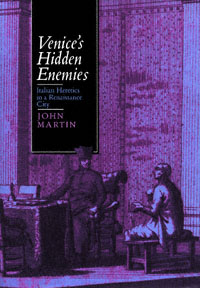 | Title: Venice's hidden enemies: Italian heretics in a Renaissance city Author: Martin, John Jeffries Published: University of California Press, 1993 Subjects: History | European History | Christianity | Renaissance History Publisher's Description: How could early modern Venice, a city renowned for its political freedom and social harmony, also have become a center of religious dissent and inquisitorial repression? To answer this question, John Martin develops an innovative approach that deftly connects social and cultural history. The result is a profoundly important contribution to Renaissance and Reformation studies.Martin offers a vivid re-creation of the social and cultural worlds of the Venetian heretics - those men and women who articulated their hopes for religious and political reform and whose ideologies ranged from evangelical to anabaptist and even millenarian positions. In exploring the connections between religious beliefs and social experience, he weaves a rich tapestry of Renaissance urban life that is sure to intrigue all those involved in anthropological, religious, and historical studies - students and scholars alike. [brief] Similar Items |
| 7. | 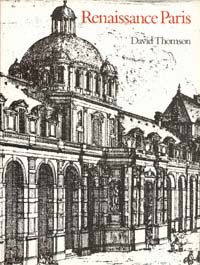 | Title: Renaissance Paris: architecture and growth, 1475-1600 Author: Thomson, David 1912- Published: University of California Press, 1985 Subjects: Art | Architecture Publisher's Description: In the modern literature on Renaissance art and architecture, Paris has often been considered the Cinderella of the European capitals. The prestigious buildings that were erected soon after François I decided in 1528 to make Paris his residence have long since been lost. Thomson, however, restores t . . . [more] Similar Items |
| 8. | 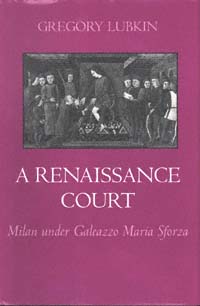 | Title: A Renaissance court: Milan under Galeazzo Maria Sforza Author: Lubkin, Gregory Published: University of California Press, 1994 Subjects: History | Renaissance History Publisher's Description: Ambitious, extravagant, progressive, and sexually notorious, Galeazzo Maria Sforza inherited the ducal throne of Milan in 1466, at the age of twenty-two. Although his reign ended tragically only ten years later, the young prince's court was a dynamic community where arts, policy making, and the panoply of state were integrated with the rhythms and preoccupations of daily life. Gregory Lubkin explores this vital but overlooked center of power, allowing the members of the Milanese court to speak for themselves and showing how dramatically Milan and its ruler exemplified the political, cultural, religious, and economic aspirations of Renaissance Italy. [brief] Similar Items |
| 9. | 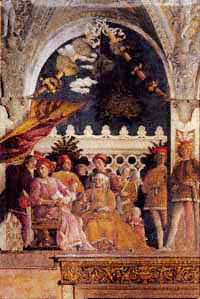 | Title: Knights at court: courtliness, chivalry, & courtesy from Ottonian Germany to the Italian Renaissance Author: Scaglione, Aldo D Published: University of California Press, 1992 Subjects: Literature | European Literature | Medieval Studies | Renaissance Literature Publisher's Description: Knights at Court is a grand tour and survey of manners, manhood, and court life in the Middle Ages, like no other in print. Composed on an epic canvas, this authoritative work traces the development of court culture and its various manifestations from the latter years of the Holy Roman Empire (ca. A.D. 1000) to the Italian Renaissance of the fifteenth and sixteenth centuries.Leading medievalist and Renaissance scholar Aldo Scaglione offers a sweeping sociological view of three geographic areas that reveals a surprising continuity of courtly forms and motifs: German romances; the lyrical and narrative literature of northern and southern France; Italy's chivalric poetry. Scaglione discusses a broad number of texts, from early Norman and Flemish baronial chronicles to the romances of Chrétien de Troyes, the troubadours and Minnesingers. He delves into the Niebelungenlied, Dante, Petrarch, Boccaccio, and an array of treatises on conduct down to Castiglione and his successors.All these works and Scaglione's superior scholarship attest to the enduring power over minds and hearts of a mentality that issued from a small minority of people - the courtiers and knights - in central positions of leadership and power. Knights at Court is for all scholars and students interested in "the civilizing process." [brief] Similar Items |
| 10. | 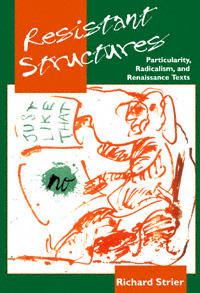 | Title: Resistant structures: particularity, radicalism, and Renaissance texts Author: Strier, Richard Published: University of California Press, 1997 Subjects: Literature | Literary Theory and Criticism | Renaissance Literature | English Literature Publisher's Description: Taking Wittgenstein's "Don't think, but look" as his motto, Richard Strier argues against the application of a priori schemes to Renaissance (and all) texts. He argues for the possibility and desirability of rigorously attentive but "pre-theoretical" reading. His approach privileges particularity and attempts to respect the "resistant structures" of texts. He opposes theories, critical and historical, that dictate in advance what texts must - or cannot - say or do.The first part of the book, "Against Schemes," demonstrates, in discussions of Rosemond Tuve, Stephen Greenblatt, and Stanley Fish among others, how both historicist and purely theoretical approaches can equally produce distortion of particulars. The second part, "Against Received Ideas," shows how a variety of texts (by Shakespeare, Donne, Herbert, and others) have been seen through the lenses of fixed, mainly conservative ideas in ways that have obscured their actual, surprising, and sometimes surprisingly radical content. [brief] Similar Items |
| 11. | 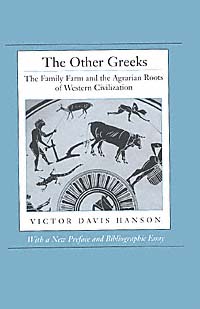 | Title: The other Greeks: the family farm and the agrarian roots of western civilization Author: Hanson, Victor Davis Published: University of California Press, 1999 Subjects: Classics | European History Publisher's Description: For generations, scholars have focused on the rise of the Greek city-state and its brilliant cosmopolitan culture as the ultimate source of the Western tradition in literature, philosophy, and politics. This passionate book leads us outside the city walls to the countryside, where the vast majority of the Greek citizenry lived, to find the true source of the cultural wealth of Greek civilization. Victor Hanson shows that the real "Greek revolution" was not merely the rise of a free and democratic urban culture, but rather the historic innovation of the independent family farm.The farmers, vinegrowers, and herdsmen of ancient Greece are "the other Greeks," who formed the backbone of Hellenic civilization. It was these tough-minded, practical, and fiercely independent agrarians, Hanson contends, who gave Greek culture its distinctive emphasis on private property, constitutional government, contractual agreements, infantry warfare, and individual rights. Hanson's reconstruction of ancient Greek farm life, informed by hands-on knowledge of the subject (he is a fifth-generation California vine- and fruit-grower) is fresh, comprehensive, and absorbing. His detailed chronicle of the rise and tragic fall of the Greek city-state also helps us to grasp the implications of what may be the single most significant trend in American life today - the imminent extinction of the family farm. [brief] Similar Items |
| 12. | 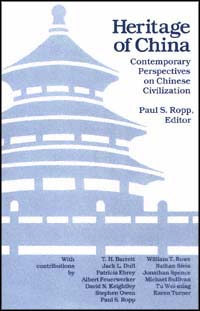 | Title: Heritage of China: contemporary perspectives on Chinese civilization Author: Ropp, Paul S 1944- Published: University of California Press, 1990 Subjects: History | China | Asian History Publisher's Description: The thirteen essays in this volume, all by experts in the field of Chinese studies, reflect the diversity of approaches scholars follow in the study of China's past. Together they reveal the depth and vitality of Chinese civilization and demonstrate how an understanding of traditional China can enri . . . [more] Similar Items |
| 13. | 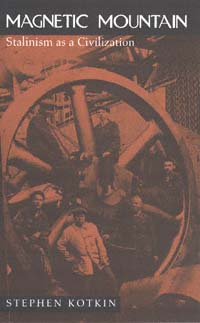 | Title: Magnetic mountain: Stalinism as a civilization Author: Kotkin, Stephen Published: University of California Press, 1997 Subjects: History | Russian and Eastern European Studies | European History Publisher's Description: This study is the first of its kind: a street-level inside account of what Stalinism meant to the masses of ordinary people who lived it. Stephen Kotkin was the first American in 45 years to be allowed into Magnitogorsk, a city built in response to Stalin's decision to transform the predominantly agricultural nation into a "country of metal." With unique access to previously untapped archives and interviews, Kotkin forges a vivid and compelling account of the impact of industrialization on a single urban community.Kotkin argues that Stalinism offered itself as an opportunity for enlightenment. The utopia it proffered, socialism, would be a new civilization based on the repudiation of capitalism. The extent to which the citizenry participated in this scheme and the relationship of the state's ambitions to the dreams of ordinary people form the substance of this fascinating story. Kotkin tells it deftly, with a remarkable understanding of the social and political system, as well as a keen instinct for the details of everyday life.Kotkin depicts a whole range of life: from the blast furnace workers who labored in the enormous iron and steel plant, to the families who struggled with the shortage of housing and services. Thematically organized and closely focused, Magnetic Mountain signals the beginning of a new stage in the writing of Soviet social history. [brief] Similar Items |
| 14. | 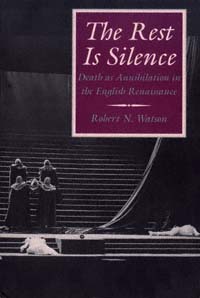 | Title: The rest is silence: death as annihilation in the English Renaissance Author: Watson, Robert N Published: University of California Press, 1995 Subjects: Literature | English Literature | Literary Theory and Criticism | Renaissance Literature Publisher's Description: How did the fear of death coexist with the promise of Christian afterlife in the culture and literature of the English Renaissance? Robert Watson exposes a sharp edge of blasphemous protest against mortality that runs through revenge plays such as The Spanish Tragedy and Hamlet , and through plays of procreation such as Measure for Measure and Macbeth . Tactics of denial appear in the vengefulness that John Donne directs toward female bodies for failing to bestow immortality, and in the promise of renewal that George Herbert sets against the threat of closure.Placing these literary manifestations in the context of specific Jacobean deathbed crises and modern cultural distortions, Watson explores the psychological roots and political consequences of denying that death permanently erases sensation and consciousness. [brief] Similar Items |
| 15. | 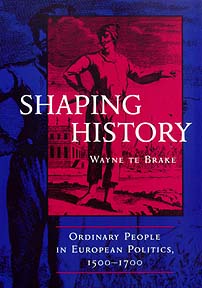 | Title: Shaping history: ordinary people in European politics, 1500-1700 Author: Te Brake, Wayne Ph Published: University of California Press, 1998 Subjects: History | European History | European Studies | Politics Publisher's Description: As long as there have been governments, ordinary people have been acting in a variety of often informal or extralegal ways to influence the rulers who claimed authority over them. Shaping History shows how ordinary people broke down the institutional and cultural barriers that separated elite from popular politics in sixteenth- and seventeenth-century Europe and entered fully into the historical process of European state formation. Wayne te Brake's outstanding synthesis builds on the many studies of popular political action in specific settings and conflicts, locating the interaction of rulers and subjects more generally within the multiple political spaces of composite states. In these states, says Te Brake, a broad range of political subjects, often religiously divided among themselves, necessarily aligned themselves with alternative claimants to cultural and political sovereignty in challenging the cultural and fiscal demands of some rulers. This often violent interaction between subjects and rulers had particularly potent consequences during the course of the Reformation, the Counter-Reformation, and the Crisis of the Seventeenth Century. But, as Te Brake makes clear, it was an ongoing political process, not a series of separate cataclysmic events. Offering a compelling alternative to traditionally elite-centered accounts of territorial state formation in Europe, this book calls attention to the variety of ways ordinary people have molded and shaped their own political histories. [brief] Similar Items |
| 16. | 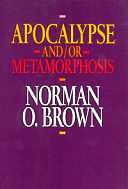 | Title: Apocalypse and/or metamorphosis Author: Brown, Norman Oliver 1913- Published: University of California Press, 1991 Subjects: Philosophy | Psychology | History Publisher's Description: Here is the final volume of Norman O. Brown's trilogy on civilization and its discontents, on humanity's long struggle to master its instincts and the perils that attend that denial of human nature. Following on his famous books Life Against Death and Love's Body , this collection of eleven essays brings Brown's thinking up to 1990 and the fall of Communism in Eastern Europe.Brown writes that "the prophetic tradition is an attempt to give direction to the social structure precipitated by the urban revolution; to resolve its inherent contradictions; to put an end to its injustice, inequality, anomie, the state of war . . . that has been its history from start to finish." Affiliating himself with prophets from Muhammad to Blake and Emerson, Brown offers further meditations on what's wrong with Western civilization and what we might do about it. Thus the duality in his title: crisis and the hope for change. In pieces both poetic and philosophical, Brown's attention ranges over Greek mythology, Islam, Spinoza, and Finnegan's Wake . The collection includes an autobiographical essay musing on Brown's own intellectual development. The final piece, "Dionysus in 1990," draws on Freud and the work of Georges Bataille to link the recent changes in the world's economies with mankind's primordial drive to accumulation, waste, and death. [brief] Similar Items |
| 17. | 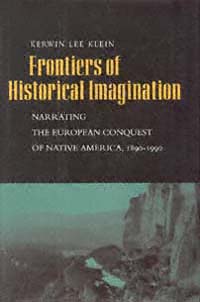 | Title: Frontiers of historical imagination: narrating the European conquest of native America, 1890-1990 Author: Klein, Kerwin Lee 1961- Published: University of California Press, 1997 Subjects: History | California and the West | American Studies | Anthropology | United States History | Intellectual History | Postcolonial Studies Publisher's Description: The American frontier, a potent symbol since Europeans first stepped ashore on North America, serves as the touchstone for Kerwin Klein's analysis of the narrating of history. Klein explores the traditions through which historians, philosophers, anthropologists, and literary critics have understood the story of America's origin and the way those understandings have shaped and been shaped by changing conceptions of history. The American West was once the frontier space where migrating Europe collided with Native America, where the historical civilizations of the Old World met the nonhistorical wilds of the New. It was not only the cultural combat zone where American democracy was forged but also the ragged edge of History itself, where historical and nonhistorical defied and defined each other. Klein maintains that the idea of a collision between people with and without history still dominates public memory. But the collision, he believes, resounds even more powerfully in the historical imagination, which creates conflicts between narration and knowledge and carries them into the language used to describe the American frontier. In Klein's words, "We remain obscurely entangled in philosophies of history we no longer profess, and the very idea of 'America' balances on history's shifting frontiers." [brief] Similar Items |
| 18. |  | Title: Trials of authorship: anterior forms and poetic reconstruction from Wyatt to Shakespeare Author: Crewe, Jonathan V Published: University of California Press, 1990 Subjects: Literature | Renaissance Literature | English Literature Publisher's Description: For more than a decade, the English Renaissance has been the scene of trial for the critical methodologies of deconstruction, feminism, new historicism, psychoanalytic poststructuralism, and cultural studies. Jonathan Crewe argues that the commitment in the prevailing criticism to innovation, transgression, and radical change has increasingly obscured some powerfully conservative elements both in Renaissance culture and in these critical discourses themselves.In a reading of the poets Wyatt, Surrey, and Gascoigne, and of the biographies of Thomas More and Cardinal Wolsey, Crewe focuses on the relatively stable poetic and cultural forms operative in the Renaissance. He argues that these established forms, which shape poetic composition, social interaction, and individual identity, are subject to only limited reconstruction by English authors in the sixteenth century. They both facilitate and limit literary and social expression and result in more sharply conflicted literary production than contemporary critics have been willing to acknowledge. Crewe concentrates on authors whose canonical status is somewhat precarious and intentionally shifts the emphasis away from the Elizabethan period and toward that of Henry VIII. Trials of Authorship redraws the existing picture of the English Renaissance in the sixteenth century. [brief] Similar Items |
| 19. | 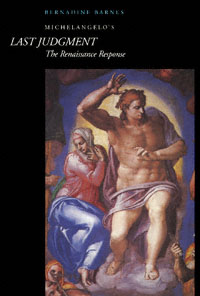 | Title: Michelangelo's Last Judgment: the Renaissance response Author: Barnes, Bernadine Ann Published: University of California Press, 1998 Subjects: Art Publisher's Description: In her analysis of Michelangelo's Last Judgment , Bernadine Barnes provides an original and stimulating view of this renowned fresco and of the audience for which it was created. Because Michelangelo is so often regarded as a nearly superhuman artistic genius, we tend to forget that his works were not created to illustrate his life. The Last Judgment did have great personal meaning for him, but his representation of this religious event was not purely self-directed, says Barnes. She argues that Michelangelo had a particular type of viewer in mind as he designed his work. The Last Judgment dealt with an especially evocative subject, and Michelangelo engaged viewers by creating highly imaginative scenes tempering fear with hope and by referring to contemporary events. The painting's original, elite audience - the papal court and a handful of distinguished lay persons - was sophisticated about art and poetry, almost exclusively male, and orthodox in its religious beliefs. That audience later broadened and included artists allowed into the Chapel to copy Michelangelo's work. These artists helped to create another, less sophisticated audience, one that knew the fresco only through reproductions and written descriptions. The response of this latter audience eventually prompted the church to censor the painting. Beautifully illustrated with photographs of the recently restored Sistine Chapel, Barnes's study greatly enhances our understanding of changing Renaissance attitudes toward art. Her book also provides valuable insights into one of Michelangelo's greatest works. [brief] Similar Items |
| 20. | 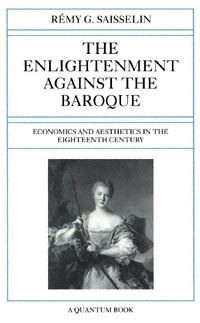 | Title: The Enlightenment against the Baroque: economics and aesthetics in the eighteenth century Author: Saisselin, Rémy G. (Rémy Gilbert) 1925- Published: University of California Press, 1992 Subjects: History | Economics and Business | Popular Culture | Art | Renaissance History Publisher's Description: How do seemingly disparate arenas of Enlightenment philosophy, economic theories, boudoir etiquette, literary styles, and artistic modes coincide in the late eighteenth century? In this poetic essay on the evolution of the idea of luxury and art, Rémy Saisselin uses precise, witty examples to describe the development of our modern taste, ultimately the successor of the more spiritual and grand baroque goût . His analysis both illuminates and distinguishes between eighteenth-century and modern varieties of conspicuous consumption.This persuasive discourse depicts the rise of luxe as an escape from ennui and shows how, for the first time in European history, a large class of wealthy, leisured people emerged to make art, luxury, and the avoidance of boredom its preoccupation. Saisselin provides an original and lucid picture of the first phases in the emergence of a specifically bourgeois taste. [brief] Similar Items |